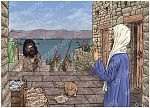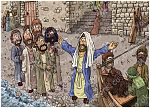Bible Cartoon: John 01 - Jesus' first disciples - Scene 04 - Philip tells Nathanael/Bartholomew
Click on Add to cart button below shopping cart.
Purchased Bible Cartoons do not have watermarks. Links to Cartoons provided on email once purchase is completed.Bible Book: John
Bible Book Code: 4300104501
Scene no: 4 of 5
Bible Reference & Cartoon Description
John 1:45-46 (ANIV)
45 Philip found Nathanael and told him, “We have found the one Moses wrote about in the Law, and about whom the prophets also wrote—Jesus of Nazareth, the son of Joseph.”
46 “Nazareth! Can anything good come from there?” Nathanael asked.
“Come and see,” said Philip.
DRAWING NOTES:
TIME OF DAY:
Unspecified in the Bible narrative. I have set this scene in the mid morning.
LIGHTING NOTES:
The sun (high up & on the left (in the east) illuminates this scene, casting shadows to the right (towards the west) & below figures & objects.
CHARACTERS PRESENT:
Left to right: Bartholomew/Nathaniel (Nathanael), Philip.
RESEARCH/ADDITIONAL NOTES:
This scene shows Philip (on the right) arriving & talking to Bartholomew/Nathaniel (aka Nathanael), who is leaning against a large Fig tree.
Like Andrew, Philip’s first reaction after meeting Jesus was to go tell someone about him. He played an active role in leading another apostle to Jesus.
Here is the scene without the figures in the foreground.

Background of John 01 – Jesus’ first disciples – Scene 04 – Philip tells Nathanael/Bartholomew
Click on the colour bar below to view/buy this Background:
Background of John 01 – Jesus’ first disciples – Scene 04 – Philip tells Nathanael/Bartholomew
“Philip’s testimony to Nathanael stressed that Jesus is the Promised One of whom Moses (Deut. 18:18-19; cf. John 1:21, 25) and the prophets (Isa. 52:13-53:12; Dan. 7:13; Micah 5:2; Zech. 9:9) wrote. Surprisingly Philip called Jesus… the son of Joseph. But this is what the disciples would have believed at this time. Yet Nathanael would soon recognize that He is “the Son of God” (John 1:49).”
[Source: Bible Knowledge Commentary]
“By the one predicted in “the Law and the Prophets” (a common Jewish designation for the Old Testament), Philip no doubt means the Messiah (e.g., Deut. 18:15-18; Isaiah 9, 11, 53).
Nazareth seems to have been a very traditional, orthodox town; priests later considered it ritually clean enough to move there. But Nazareth was relatively small and obscure, with about sixteen hundred to two thousand inhabitants. It lay about four miles from the massive city of Sepphoris, which rivalled Tiberias (John 6:23) for its urban Greek character in Jewish Galilee.”
[Source: Bible Background Commentary]
The Fig tree
The tree Bartholomew/Nathaniel is sitting under is a Ficus carica (aka Fig). A plant of the Moraceae (Mulberry) family. The common fig is indigenous to an area extending from Asiatic Turkey to northern India, but natural seedlings grow in most Mediterranean countries; it is cultivated in warm climates. In the Mediterranean region the fig is so widely used, both fresh and dried, that it is called “the poor man’s food.” The fruit contains significant amounts of calcium, potassium, phosphorus, and iron.
The fig was one of the earliest fruit trees to be cultivated, and its cultivation spread in remote ages over all the districts around the Aegean Sea and throughout the Levant. The Greeks are said to have received it from Caria (hence the specific name); Attic figs became celebrated in the East, and special laws were made to regulate their exportation. The fig was one of the principal articles of sustenance among the Greeks; the Spartans especially used it at their public tables.
Physical description
The fig plant is a bush or small tree, from 3 feet (1 metre) to 33 to 39 feet (10 to 12 metres) high, with broad, rough, deciduous leaves that are deeply lobed or sometimes nearly entire. The leaves and stems exude a white latex when broken.
Fig fruits, known as syconia, are borne singly or in pairs above the scars of fallen leaves or in axils of leaves of the present season. Flowers are staminate (male) or pistillate (female) and enclosed within the inflorescence structure.
[Source: Encyclopaedia Britannica (https://www.britannica.com/plant/fig).]





